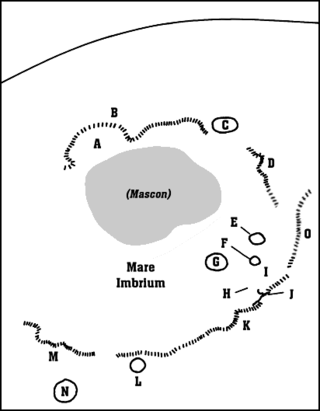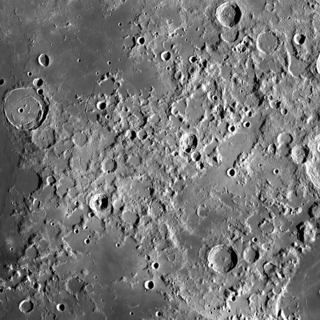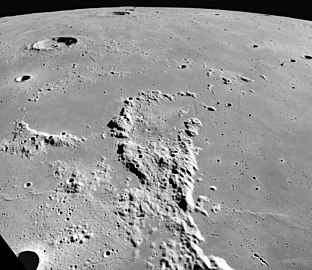
Mare Orientale is a lunar mare. It is located on the western border of the near side and far side of the Moon, and is difficult to see from an Earthbound perspective. Images from spacecraft have revealed it to be one of the most striking large scale lunar features, resembling a target ring bullseye.

Mare Serenitatis is a lunar mare located to the east of Mare Imbrium on the Moon. Its diameter is 674 km (419 mi).

Montes Haemus is a mountain range that forms the southwestern edge of the Mare Serenitatis basin on the Moon. They form a less prominent mirror image of the Montes Apenninus range to the west, and curve up to nearly join at the northern end. The eastern edge terminates with the Promontorium Archerusia, to the northwest of the crater Plinius. This end reaches a gap where the Mare Serenitatis to the north joins the Mare Tranquillitatis to the south.

Aristoteles is a lunar impact crater that lies near the southern edge of the Mare Frigoris and to the east of the Montes Alpes mountain range. It was officially named in 1935 after the ancient Greek philosopher Aristotle by the International Astronomical Union, using the classical form of his name.

Euclides is a small lunar impact crater located near the eastern edge of Oceanus Procellarum, about 30 kilometers to the west of the Montes Riphaeus mountains. The mare in the vicinity is devoid of significant craters, but to the west is an area of low rises. The crater is named after the Greek mathematician Euclid.

Aratus is a small lunar impact crater located on the highland to the south and east of the rugged Montes Apenninus range. It is a circular, cup-shaped crater with a relatively high albedo. It was named after Greek astronomer Aratus of Soli. To the east is the Mare Serenitatis, and to the southwest is the somewhat larger crater Conon. North-northeast of Aratus is the landing site of the Apollo 15 mission, just beyond Mons Hadley Delta.

Conon is a small but prominent lunar impact crater that lies in the eastern foothills of the Montes Apenninus mountain range. The crater is named for the Greek astronomer Conon of Samos. Just to the west of Conon is the long mountainous ridge Mons Bradley. The nearest craters possessing an eponym are Galen, about 70 kilometres (43 mi) to the east, and Aratus, about the same distance to the northeast.

Montes Alpes is a mountain range in the northern part of the Moon's near side. It was named after the Alps in Europe; the name was confirmed by the International Astronomical Union in 1935. It lies between the selenographic coordinates latitudes 52.81°N and 42.04°N, and longitudes 5.6°W and 3.22°E. The range thus crosses the lunar prime meridian, and is partially illuminated and partially in shadow during first and last quarters. The center of the range is at 48.36°N, 0.58°W, and has a diameter of 334 km.

Montes Jura is a mountain range in the northwest part of the near side of the Moon. The selenographic coordinates of this range are 47.1° N 34.0° W. It has a diameter of 422 km, with mountains rising to approximately 3800m above the level of Sinus Iridum. They were named after the Jura Mountains in eastern France / western Switzerland.

Santos-Dumont is a small lunar impact crater that lies in the northern end of the Montes Apenninus range at the eastern edge of the Mare Imbrium. It is located about 30 kilometers to the northeast of Mons Hadley, a mountain massif.

Focas is a small lunar impact crater that lies on the far side of the Moon, just past the southwestern limb. In this location the crater is occasionally brought into view due to libration, but not much detail can be seen because the crater is viewed from the side.

Montes Cordillera is a mountain range on the Moon. This feature forms the outer wall of peaks that surround the Mare Orientale impact basin, the inner ring being formed by the Montes Rook. The center of the range is located at selenographic coordinates 17.5° S, 81.6° W, and the diameter is 574 km (357 mi).

Mons Piton is an isolated lunar mountain that is located in the eastern part of the Mare Imbrium, to the north-northwest of the crater Aristillus. Due east of Mons Piton is the flooded crater Cassini, and to the west-northwest lies Piazzi Smyth. North and northeast of this massif is the Montes Alpes range, forming the northeast edge of the lunar mare.

Mons Hadley is a massif in the northern portion of the Montes Apenninus, a range in the northern hemisphere of the Moon. It has a height of 4.5 km (2.8 mi) 14,764 ft (4,500 m) above the adjacent plain and a maximum diameter of 25 km at the base.

Mons Bradley is a lunar mountain massif in the Montes Apenninus range, along the eastern edge of the Mare Imbrium. It is located to the west of the crater Conon. To the west of this peak is the Rima Bradley rille.

Montes Taurus is a rugged, jumbled mountainous region on the Moon. It is located to the east of the Mare Serenitatis, in the northeastern quadrant of the Moon's near side. Coordinates of their center are 27.32°N 40.34°E, and their extent is about 170 km.

Mons Hadley Delta (δ) is a massif in the northern portion of the Montes Apenninus, a range in the northern hemisphere of the Moon adjacent to Mare Imbrium. It has a height of 3.6 km above the plains to the north and west.

In Greco-Roman geography, the Riphean Mountains were a supposed mountain range located in the far north of Eurasia. The name of the mountains is probably derived from Ancient Greek: ῥιπή. The Ripheans were often considered the northern boundary of the known world. As such, classical and medieval writers described them as extremely cold and covered in perennial snow. Ancient geographers considered the Ripheans the source of Boreas and several large rivers. The location of the Ripheans, as described by most classical geographers, would correspond roughly with the Volga region of modern-day Russia.

Montes Apenninus are a rugged mountain range on the northern part of the Moon's near side. They are named after the Apennine Mountains in Italy. With their formation dating back about 3.9 billion years, Montes Apenninus are fairly old.

Hadley–Apennine is a region on the near side of Earth's Moon that served as the landing site for the American Apollo 15 mission, the fourth crewed landing on the Moon and the first of the "J-missions", in July 1971. The site is located on the eastern edge of Mare Imbrium on a lava plain known as Palus Putredinis. Hadley–Apennine is bordered by the Montes Apenninus, a mountain range, and Hadley Rille, a meandering channel, on the east and west, respectively.





















